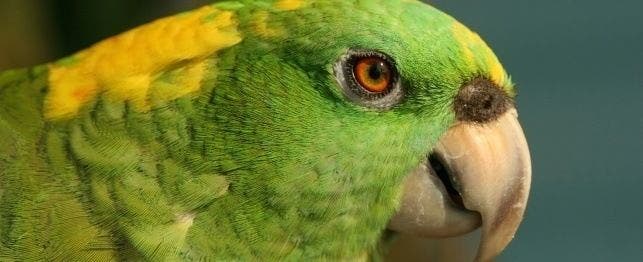
Choosing a Yellow-naped Amazon
Yellow-naped Amazons, whose formal scientific name is Amazona ochrocephala auropalliata, are well-known talkers. They are highly intelligent and probably the best mimics of all neotropical parrots. They are, on the other hand, extremely aggressive. Mature males can be exceedingly dangerous – to both their mates and to humans.
Females can be reasonably good pets for singles, though they are too dangerous for kids and too loud for seniors. They are relatively common in captivity and often available for pets, typically costing between $900 and $1,200. They are active by nature and have a tendency toward obesity if closely confined.
Appearance
These stocky, bright green birds are relatively large (about 14 to 15 inches long), with the males typically larger than the females. In young birds, the eyes are brown and the color changes as the birds age. In mature birds, they are orange-yellow.
Natives of the coastal areas of Central America, the birds have a yellow patch at the nape of the neck, which gives them their name. Some young birds may have a small yellow front, but most are entirely green until approximately three to five years, when the yellow nape emerges. Small red splashes are often found on the birds’ shoulder.
Flight feathers are green with blue tips; tail feathers have yellow-green tips and red patches on the outer feathers. The most popular variety of yellow napes have a horn-colored beak tipped with black.
Yellow-naped Amazons can probably live up to 50 to 60 years or more, but little is known about their life span in captivity.
Grooming
Routine bathing or showering is vital to maintaining good plumage and skin condition. You can mist your bird and allow her to dry in a warm room or in the sun, or gently dry her with a blow dryer. Care should be taken not to clip the wing feathers excessively as Amazons are heavy bodied and excessive wing clipping can result in injuries from falling. Clip only the primary flight feathers and only enough so the bird will glide to the floor.
Feeding
Amazons should be fed a pelleted diet supplemented with fresh fruits and vegetables daily to add variety. Feed approximately 1/4 to 1/3 cup of pellets and 1/4 to 1/3 cup of fresh fruits and vegetables. You should monitor food intake because overfeeding leads to pickiness, selective feeding and wasteful throwing of food. Because of their tendency to obesity, yellow-naped Amazons should be fed few or no sunflower or safflower seeds (seeds should only be given as treats).
Vitamin supplements are not needed for birds on a pelleted diet. However, birds fed only seeds need vitamin and mineral supplementation to prevent deficiency diseases. Add vitamins to soft food; don’t add them to the birds’ water, as this dilutes the vitamins. Water-soluble vitamins break down rapidly and water with sweetened vitamins is a good growth medium for bacteria. Vitamins added to seeds are usually lost when the bird shells the seeds.
Housing
Yellow-naped Amazons are very active and should be provided the largest cage that space and budget allows. Ideally, the cage should provide room for flight. Durable cage construction is not as critical as it is for macaws and cockatoos, but locks or escape-proof latches may be necessary. If possible, the bird should also have an outdoor cage to allow playtime in the fresh-air and sunlight.
Breeding
Breeding age is approximately three to five years. Yellow-naped Amazons are relatively difficult to breed in captivity and they can be noisy. When breeding Amazons tend to be noisy and proximity to neighbors must be considered.
In North America, the birds breed predominantly in the spring and have a limited breeding season that typically runs from February or March to June or July. Clutch size is usually three to four eggs.
For breeding cage construction, use 1-inch by 1-inch 14-gauge welded wire. A suggested size is 4 feet by 4 feet by 8 feet long suspended 4 feet above the ground or floor. You can use wooden nest boxes approximately 12 inches by 12 inches by 24 inches.
The incubation period is approximately 24 to 26 days and chicks usually fledge at approximately 10 to 12 weeks of age. Yellow-naped Amazons are relatively easy to hand-rear and most hand-rearing formulas can be used successfully.
Common Disease and Disorders
Amazons are relatively healthy birds but are susceptible to the following:
- Mate aggression
- Feather-picking
- Psittacosis
- Poor eating habits
- Bacterial and fungal infections
- Obesity
- Toxicity, ingestion of metals
- Toe necrosis